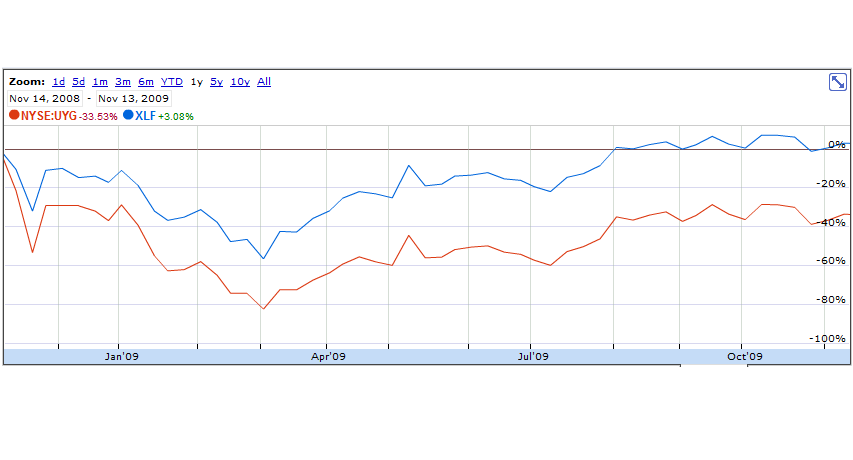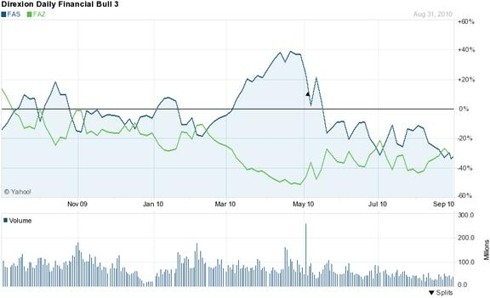Leveraged ETFs Versus Margin ETFs (FAS) (FAS)
Post on: 20 Апрель, 2015 No Comment

Both leveraged exchange-traded funds (ETFs) and buying ETFs on margin allow you to maximize your upside potential by using debt. On the other hand, if your investments don’t go well then you’re going to suffer substantial losses. The key is to figure out which option is better. But first it’s important to understand the difference.
Leveraged ETFs
A leveraged ETF tracks an index, industry, commodity or currency to name a few. There are also inverse leveraged ETFs which means the price-per-share for the ETF appreciates when that index, industry, commodity or currency performs poorly. Many investors like these trading vehicles because they offer a lot of potential in a short period of time and offer an opportunity to bet big without having to use personal leverage. To this last point, a broker won’t offer margin on a high risk asset because of the possibility for default. (For more, see: Dissecting Leveraged ETF Returns ).
As far as having an opportunity to bet big, it’s important to remember that there is no such thing as a low risk investment with exceptional rewards. In other words, while the potential returns are large, the downside risk is also multiplied. If you read the fine print, most funds will recommend that you don’t stay invested in a leveraged ETF longer than one day. The reason for this is because fees and expenses will eat into your profits. Many leveraged ETFs have net expense ratios of 0.95%. This is considerably higher than the average ETF expense ratio of 0.46%.
Loading the player.
The above recommendation by most funds presents a problem. It has consistently been proven that active trading isn’t as profitable as a long term investment strategy. This is because it’s impossible to time the market on a sustainable basis. However, if you were to buy and hold a leveraged ETF your profits would be reduced due to fees and expenses – if you had profits.
In most cases, leveraged ETFs present a lose/lose scenario. That said, there are exceptions and the rewards can be enormous. For instance, the Direxion Daily Financial Bull 3X ETF (FAS ) closed at $51.46 on April 18, 2013 and $132.13 on December 29, 2014. This is despite an expense ratio of 0.95%. Sometimes an industry can be performing so well that gains offset costs. (For more, see: Leveraged ETFs: Are They Right for You? ).
Buying ETFs on Margin

As mentioned above, you can’t buy a leveraged ETF on margin. You can use margin to invest in a standard ETF. With a margin account you’re borrowing money to invest in securities which can significantly increase your upside potential. On the other hand, it can also lead to a margin call if your investment(s) sour, which means you, the investor, must deposit further cash or securities to cover possible losses. (For more, see: A Guide for Buying ETFs on Margin ).
If you use margin to buy an ETF, the interest will depend on the length of the loan. If it’s a longer loan that interest will eat into your profits. On the positive side, with a margin account interest owed can be paid down via dividends and other sources of available capital.
The Bottom Line
Though there are exceptions on both sides, in general, if you’re looking for a short term investment with significant upside potential a leveraged ETF will be a better option. If you’re looking for a long term investment where you can maximize your potential by using margin, buying on margin will be a better option especially if you can use dividends to pay down the interest. All that said, leveraged ETFs and buying on margin are both high risk. Since capital preservation should be your number one priority when aiming for long term investing success, it’s recommend that both be avoided. (For more, see: Top 5 Reasons to Keep Leveraged ETFs to the Pros ).
Dan Moskowitz does not have any positions in FAS.














